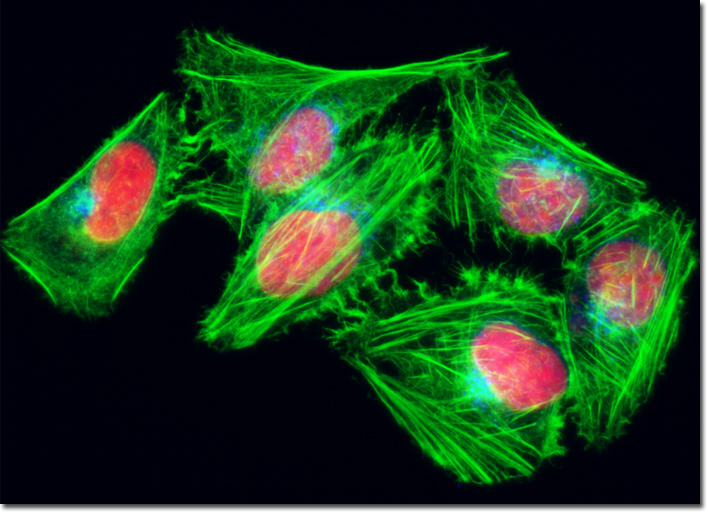Fluorescence Digital Image Gallery
Pig Kidney Epithelial Cells (LLC-PK1)
|
Propidium iodide is a phenanthridine derivative that was originally synthesized as an anti-trypanosomal agent. The popular, traditional probe binds to DNA via intercalation to produce orange-red fluorescence centered at 617 nanometers. Positively charged, propidium iodide also exhibits a high affinity for double-stranded RNA, resulting in the necessity of treating cell cultures containing both nucleic acids with nucleases in order to distinguish between them. The absorption maximum of the fluorophore is 536 nanometers, making it suitable for excitation with either the 488-nanometer or 514-nanometer spectral lines of an argon-ion (or krypton-argon) laser, or the 543-nanometer line from a green helium-neon laser. Propidium iodide is often utilized in fluorescence microscopy as a counterstain to highlight cell nuclei during double or triple labeling experiments. The dye is membrane impermeant, typically being excluded from viable cells in a population. In order to target the cytoskeletal F-actin network and nuclei present in the LLC-PK1 monolayer culture presented above, the cells were first stained with Alexa Fluor 488 conjugated to phalloidin and propidium iodide, respectively. The culture was also labeled with the probe Alexa Fluor 350 conjugated to wheat germ agglutinin, a lectin that selectively binds to sialic acid residues, which are found in both mucoproteins and glycoproteins. Images were recorded in grayscale with a QImaging Retiga Fast-EXi camera system coupled to an Olympus BX-51 microscope equipped with bandpass emission fluorescence filter optical blocks provided by Omega Optical. During the processing stage, individual image channels were pseudocolored with RGB values corresponding to each of the fluorophore emission spectral profiles. |
© 1995-2025 by Michael W. Davidson and The Florida State University. All Rights Reserved. No images, graphics, software, scripts, or applets may be reproduced or used in any manner without permission from the copyright holders. Use of this website means you agree to all of the Legal Terms and Conditions set forth by the owners.
This website is maintained by our
|
